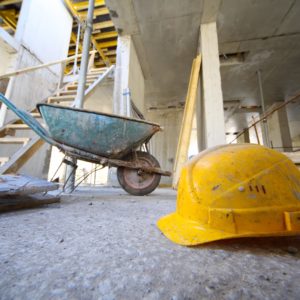Div 40 ITAA 97 is about the deprecation of plant and equipment.
Div 40 ITAA 97
Division 40 used to be a goldmine for property investors. You were able to depreciate used assets, even if the previous owner had already completely written them off. Unfortunately, this ain’t no more, but still: better less than nothing. But let’s start from the beginning.
Div 40
Division 40 is about depreciation. Funnily enough, Div 40 doesn’t actually say ‘depreciation’. It talks about deductions.
But it does talk about ‘depreciating assets’. So you claim a deduction for depreciating assets. Go figure.
And on top of that, the ATO refers to Div 40 as the uniform capital allowance provisions. So in the words of the ATO a deduction under Div 40 is a capital allowance. Go figure again.
That’s the first reason why all this is so confusing. It is as if the legislator and the ATO invented another language, but didn’t agree on what to call what.
Depreciating Assets
Div 40 is about depreciating assets. Not everything is a depreciating asset though.
Land and trading stock are not depreciating assets.
But in-house software, patents, licences and copyrights are per s 40-30(2) ITAA97.
Components
What is a depreciating asset? Do you treat a composite item as one depreciating asset? Or do you treat all its components as separate depreciating assets?
So do you treat the car as one asset? Or all its components (engine, tyres, wheel and so on) as separate assets? How far do you go? Do you go down to each screw?
This question is as old as the idea of accounting itself. There is no black-and-white rule. Do what makes sense to you.
Or in ATO talk,
“This is a question of fact and degree in the circumstances (see examples under s 40-30(4) ITAA97; and Draft TR2017/D).”
Ignore Actual Change in Value
The decline in value is based on the cost and effective life of the depreciating asset, not its actual change in value.
So let’s say you buy a super expensive machine and the next day the supplier offers a 50% discount – just making this up – that doesn’t mean you can claim a Div 40 deduction of 50%. Div 40 is about cost and effective life, not about actual change in value.
Economic Owner
Only the holder of an asset can claim a deduction. Usually, the holder is the legal owner of the asset.
But sometimes, the economic owner is different to the legal owner – for example when you buy the asset through a trust. In that case, the economic (beneficial) owner will be the holder. So the trust would claim the deduction, not the trustee.
Sometimes it is tricky to work out who the holder is. Section 40-40 ITAA97 includes a table that should help you.
Residential Properties
New is In. Old is out in Div 40. But only for residential properties.
If you purchase new plant and equipment for your residential property, you can claim a deduction over the effective life of the asset. But not for used assets that came with the property when you bought.
Let’s use a fridge as an example. If you buy a new fridge for your investment property, you can deduct it. If the fridge came with the property, bad luck – no deduction.
This rule is actually not that old. Before 2017 you could deduct all assets. Even if they had come with the property. And even if the previous owner had already claimed a full deduction. You could claim a full deduction again. So some assets were deducted x times over the years. Now looking back, it feels strange to think that this was even possible.
The changes applied from 1 July 2017 onwards for previously used plant and equipment acquired at or after 7.30 pm on 9 May 2017 unless it was acquired under a contract entered into before this time. The changes also applied to plant and equipment acquired before 1 July 2017 but not used to earn income in either the current or previous year.
Now all this only applies to residential properties. Not to businesses. And also not to companies. So if you happen to hold your investment properties within a company – which you usually wouldn’t, since companies don’t qualify for the 50% CGT discount – but if you did, then this rule wouldn’t affect you and you could still claim a deduction for used assets.
Methods
There are two methods to depreciate your asset, ie. calculate your Div 40 deduction. The prime cost method and the diminishing value method.
The prime cost method is easy to understand but you probably won’t use it. The diminishing value method is tricky to understand, but that is the one you will most likely use. Why?
Because the diminishing value method gives you a lot more deductions upfront. And that is what you want. You want to claim as many deductions as possible right at the start to help your cash flow and reduce your loan balance and hence interest.
But never say never. Maybe you have a low marginal tax rate at the moment and expect it to increase (for example when other properties will feed you fewer losses in the next few years), and hence you want to push your deductions into those future years. Then you might go for the prime cost method.
But we digress. The main point is that you need to choose well. Once you choose a method for a particular asset, you can’t change the method for that asset (s 40-65 ITAA97).
Prime Cost
The prime cost method lives in s40-75 ITAA97. The formula is:
Cost of asset / Effective life
Let’s say you pay AUD 1,000 for a fridge and the effective life is 5 years, you claim AUD 200 each year. Easy, right?
Diminishing Value
The diminishing value (‘DV’) method is harder to grasp. Not rocket science. But doesn’t intuitively make sense like the prime cost method.
The DV method lives in s 40-70 ITAA 97. The formula is:
Base value* x 200%/ Effective life
* The concept of base value is defined in s 40-70(1).
Start Time
Your asset starts to decline when its “start time” occurs. This is when you first use the asset or have it installed and ready for use (s40-60).
If you only hold an asset for part of a year, then you pro rata the deprecation for that year. You multiply the depreciation for the full year with the quota of days held (Days held/ 365).
Effective Life
Broadly, the effective life of a depreciating asset is the period you can use it to produce income. Under the capital allowance rules, you are allowed to either self-assess the effective life.
Or you can use the Commissioner’s effective life rate listed in the taxation ruling for that year. Just google ‘Commissioner’s effective life for xxxx’ and the relevant TR will come up.
Cost of Depreciating Assets
The cost of a depreciating asset consists of two elements (Subdivision 40-C ITAA97):
1 – expenses you incur to start holding the asset (s40-180 ITAA97), for example, purchase price and stamp duty, and
2 – additional expenses that contribute to its present condition and location (s40-190 ITAA97), mainly capital improvements.
Not Included in Costs
Not included in the cost of an asset for Div 40 are GST input credits, amounts deductible outside Div40 and expenses not of a capital nature (s40-220 ITAA97).
For some assets, especially cars, you have to reduce the cost to a certain limit. For cars, this is the so-called car limit (s 40-230 ITAA97), except when modifications are made for the use of disabled individuals (s 40-230(2).
Balancing Adjustments
When you sell the asset, then it gets complicated. And the reason it gets complicated is that Subdiv 40-D talks about the uniform capital allowance (‘UCA’) provisions, not about adding back depreciation. But that is what it is about.
In tax language, you claimed a deduction. And when you sell the item for more or less, then you have to add back or deduct more. That is the so-called balancing adjustment (s40-295(1) ITAA97).
Let’s say you bought a machine for AUD 10,000 and you have claimed deductions for AUD 9,000. So the book value is AUD 1,000.
But now you sell the machine for AUD 5,000. So you need to add AUD 4,000 back through a balance adjustment.
Or you sell it for AUD 100. Then you need to deduct another balancing adjustment of AUD 900.
And since you claim all this under Div 40, you can ignore any CGT.
That’s it. In official lingo all this sounds as follows – and hopefully, it now makes sense to you:
“An amount is included in assessable income when the termination value (sales price) of a depreciating asset is more than its adjustable value (written down value) (s40-285(1)).
An amount is deducted from assessable income when the termination value of a depreciating asset is less than its adjustable value (written down value) (s 40-285(2)).
There is a reduction to the amount included in or deducted from assessable income in proportion to the extent of the private use of the depreciating asset (s 40-290).
To the extent that a balancing adjustment event happens in relation to the income-producing portion of the depreciating asset, any capital gain or loss from a CGT event that also happens is disregarded (s 118-24 ITAA97). This is because the gain or loss on the income-producing portion is recognised under the balancing adjustment rules in Div40.”
Termination Value
The ‘termination value’ aka sales value of a depreciating asset is worked out using the table in s40-300. It generally includes the amounts that you received (or were taken to have received, ie. non-cash benefits) in relation to the asset.
An amount received for two or more things will be apportioned between the termination value of the depreciating asset and those other things.
The termination value does not include expenses relating to balancing adjustments.
If you use a depreciating asset for a non-taxable purpose, reduce the balancing adjustment to reflect that non-taxable use. The reduced balancing adjustment amount is included in, or deducted from your assessable income under the UCA provisions.
Immediate Deductions
You can claim an immediate deduction for certain capital expenditure, rather than stretching it out over several years. The list can be confusing, since there is a fair bit of overlap, but here we go:
You can claim an immediate deduction for:
- Mining Costs (Subdiv 40-H)
- Landcare operations (Subdiv 40-F and G)
- Non-Business (‘Minor’) Assets AUD 300 (s 40-80(2))
- Business Assets AUD 100 (PS LA 2003/8)
- Low-Value Pool Assets and Software AUD 1,000 (Subdiv 40-E)
All ITAA97.
Mining Costs
When you pay for exploration, prospecting, rehabilitation of mine and quarry sites, petroleum taxes, and environmental protection activities you have the option of an immediate deduction (Subdiv 40-H).
AUD 300 Non-Business (‘Minor ‘) Assets
This is the non-business deduction. You can claim an immediate deduction if the asset is not used in your business and is:
- AUD 300 or less;
- Used for employment, investment or rental property, so non-business
- Not part of an asset that costs AUD 300 more;
- Not identical to other assets bought in the same year that together costs more than AUD 300.
Example: You buy four matching chairs – each AUD 200 – for your rental property. No immediate deduction since the chairs are substantially identical and their total cost exceeds AUD 300.
AUD 100 Business Assets
This is the business deduction.
You can directly expense any expenditure of AUD 100 or less (GST-included) incurred to acquire a tangible asset in the ordinary course of carrying on a business
Examples per PS LA 2003/8.:
- Office: hand-held staplers, hole punches, manila folders, ring binders, calculators, tape dispensers, scissors and labelling machines.
- Cafe: cutlery, saucers, cups and table linens.
- Tradie: pliers, screwdrivers and hammers.
AUD 1,000 Pool Assets
You can allocate the following assets to a low-value pool:
- Low-Cost Assets: Costing less than AUD 1,000 (s40-425(1) ITAA97)
- Low-Value Assets: Declined in value under the diminishing value method to less than AUD 1,000 (s40 425(3)).
Now it gets a bit complicated. You treat low-cost and low-value assets differently.
Low-Cost
The deprecation of low-cost assets added to the pool during the year is at half the pool rate (18.75%).
If you start to pool low-cost assets, you must do so for all such assets of that year. And you must also do that in future years.
Low-Value
You work out the decline in value for assets in the low-value pool on a diminishing value basis. And you pretend that all the pooled assets had an effective life of four years (37.5%).
The depreciation of low-value assets allocated to the pool during the year is at the full pool rate (37.5%).
Section 40-440(1) ITAA97 details the method used to calculate the decline in value of the low-value pool. While s 40-440(2) details how to calculate the closing pool balance itself.
If you sell a pool asset during the year, you deduct the sale price from the closing pool balance. But only to the extent it reaches zero (s 40-445(1) ITAA97). The amount in excess of zero becomes assessable income (s 40-445(2)).
So that was a very quick run through Div 40. As long as you don’t pool, it is relatively straightforward. Just the pooling can be confusing.
MORE
UPE in the Maximum Net Asset Value Test
Disclaimer: Tax Talks does not provide financial or tax advice. All information on Tax Talks is of a general nature only and might no longer be up to date or correct. You should seek professional accredited tax and financial advice when considering whether the information is suitable to your or your client’s circumstances.
Last Updated on 18 April 2023



